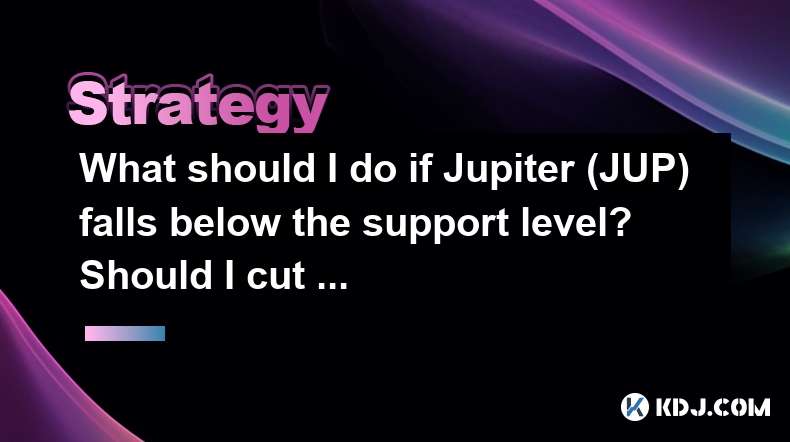-
 bitcoin
bitcoin $122025.899241 USD
-2.12% -
 ethereum
ethereum $4488.068729 USD
-4.11% -
 bnb
bnb $1315.348019 USD
8.65% -
 tether
tether $1.000457 USD
0.03% -
 xrp
xrp $2.875326 USD
-3.69% -
 solana
solana $222.043604 USD
-4.07% -
 usd-coin
usd-coin $0.999682 USD
0.00% -
 dogecoin
dogecoin $0.249887 USD
-5.62% -
 tron
tron $0.337379 USD
-2.59% -
 cardano
cardano $0.827763 USD
-5.06% -
 hyperliquid
hyperliquid $45.774531 USD
-2.43% -
 chainlink
chainlink $22.079309 USD
-5.87% -
 ethena-usde
ethena-usde $1.000156 USD
0.02% -
 sui
sui $3.482566 USD
-3.57% -
 stellar
stellar $0.386982 USD
-4.92%
What should I do if Jupiter (JUP) falls below the support level? Should I cut my losses or continue to cover my position?
If JUP falls below support, assess your strategy, risk tolerance, and market conditions to decide whether to cut losses or hold, using tools like stop-loss orders and technical analysis.
May 06, 2025 at 10:07 am

If Jupiter (JUP) falls below the support level, deciding whether to cut your losses or continue to cover your position can be challenging. This decision depends on various factors, including your investment strategy, risk tolerance, and the current market conditions. Let's explore the steps you should consider in such a scenario.
Understanding Support Levels
Support levels in cryptocurrency trading are price points where a downtrend is expected to pause due to a concentration of demand. When JUP falls below a support level, it suggests that the selling pressure has overcome the buying interest, potentially signaling further declines. It's essential to understand that support levels are not guarantees; they are merely indicators.
Assessing Your Investment Strategy
Before making any decisions, revisit your investment strategy. Are you a long-term investor who believes in the fundamental value of JUP, or are you a short-term trader looking to capitalize on price movements? Long-term investors might be more inclined to hold through volatility, while short-term traders might look to cut losses quickly to preserve capital.
Evaluating Risk Tolerance
Your risk tolerance plays a crucial role in this decision. If you are comfortable with the potential for further losses and have a high risk tolerance, you might choose to hold your position. Conversely, if you prefer to minimize risk, cutting losses might be the better option. Consider how much of your portfolio JUP represents and whether you can afford to lose more.
Analyzing Market Conditions
Take a closer look at the current market conditions. Are other cryptocurrencies experiencing similar declines, or is JUP's drop isolated? Broader market trends can influence your decision. If the entire market is bearish, holding might be riskier. Additionally, check for any news or developments specific to JUP that might have triggered the drop.
Technical Analysis
Perform a technical analysis to gain more insight. Look at indicators such as moving averages, RSI (Relative Strength Index), and MACD (Moving Average Convergence Divergence). These can help you determine if the fall below the support level is a temporary dip or part of a longer-term trend.
- Moving Averages: If JUP is trading below its moving averages, it might indicate a bearish trend.
- RSI: An RSI below 30 suggests that JUP might be oversold, potentially indicating a buying opportunity.
- MACD: A bearish crossover on the MACD can confirm downward momentum.
Setting Stop-Loss Orders
One practical approach is to use stop-loss orders. These automatically sell your JUP if the price falls to a certain level, helping you manage risk. To set a stop-loss order:
- Log into your trading platform.
- Navigate to your JUP position.
- Select the option to set a stop-loss order.
- Enter the price at which you want to sell if JUP falls further.
- Confirm the order.
Considering Averaging Down
If you decide to continue covering your position, you might consider averaging down. This involves buying more JUP at the lower price to reduce your average cost per unit. However, this strategy increases your exposure and should be approached cautiously.
- Calculate your new average cost if you buy more JUP.
- Assess whether you have the financial capacity to increase your investment.
- Consider the potential for further declines and how they might affect your portfolio.
Emotional Discipline
Maintaining emotional discipline is vital. Fear and greed can cloud judgment, leading to poor decision-making. Stick to your strategy and avoid making impulsive decisions based on short-term price movements.
Consulting with a Financial Advisor
If you're unsure, consider consulting with a financial advisor who specializes in cryptocurrencies. They can provide personalized advice based on your financial situation and goals.
Monitoring and Adjusting
Finally, keep monitoring the situation and be prepared to adjust your strategy. Cryptocurrency markets can be volatile, and what works today might not work tomorrow. Stay informed about JUP's performance and any new developments that might affect its price.
Frequently Asked Questions
Q: Can I use technical analysis tools to predict if JUP will recover after falling below the support level?A: While technical analysis tools can provide insights into potential price movements, they cannot predict the future with certainty. Tools like moving averages, RSI, and MACD can help identify trends and potential reversal points, but they should be used in conjunction with other forms of analysis and market information.
Q: How often should I review my JUP position if it falls below the support level?A: It's advisable to review your JUP position regularly, especially during periods of high volatility. Daily or weekly reviews can help you stay informed about price movements and market conditions, allowing you to make timely decisions.
Q: Is it better to diversify my portfolio if JUP falls below the support level?A: Diversification can help mitigate risk, especially if you're concerned about JUP's performance. By spreading your investments across different cryptocurrencies or other assets, you can reduce the impact of a decline in any single holding. However, diversification should align with your overall investment strategy and risk tolerance.
Q: Should I consider the volume of JUP trades when deciding whether to cut my losses or hold?A: Yes, trading volume can provide valuable insights. High trading volume accompanying a price drop might indicate strong selling pressure, suggesting that cutting losses could be wise. Conversely, if the volume is low, the drop might be less significant, and holding could be more appropriate. Always consider volume in the context of other market indicators.
Disclaimer:info@kdj.com
The information provided is not trading advice. kdj.com does not assume any responsibility for any investments made based on the information provided in this article. Cryptocurrencies are highly volatile and it is highly recommended that you invest with caution after thorough research!
If you believe that the content used on this website infringes your copyright, please contact us immediately (info@kdj.com) and we will delete it promptly.
- BlockDAG, DOGE, HYPE Sponsorship: Crypto Trends Shaping 2025
- 2025-10-01 00:25:13
- Deutsche Börse and Circle: A StableCoin Adoption Powerhouse in Europe
- 2025-10-01 00:25:13
- BlockDAG's Presale Buzz: Is It the Crypto to Watch in October 2025?
- 2025-10-01 00:30:13
- Bitcoin, Crypto, and IQ: When Genius Meets Digital Gold?
- 2025-10-01 00:30:13
- Stablecoins, American Innovation, and Wallet Tokens: The Next Frontier
- 2025-10-01 00:35:12
- NBU, Coins, and Crypto in Ukraine: A New Yorker's Take
- 2025-10-01 00:45:14
Related knowledge

Practical parameter settings for a Bitcoin multi-timeframe moving average system
Sep 18,2025 at 10:54pm
Optimizing Timeframe Combinations for Bitcoin Trading1. Selecting appropriate timeframes is crucial when building a multi-timeframe moving average sys...

How can I filter out false breakouts in Dogecoin high-frequency trading?
Sep 22,2025 at 01:00am
Understanding False Breakouts in Dogecoin Trading1. A false breakout occurs when Dogecoin's price appears to move beyond a defined support or resistan...

Techniques for identifying tops and bottoms in the Bitcoin on-chain NVT model
Sep 20,2025 at 07:54pm
Understanding the NVT Model in Bitcoin Analysis1. The Network Value to Transactions (NVT) ratio is often described as the 'P/E ratio' of the cryptocur...

What does the surge in open interest in Bitcoincoin futures mean?
Sep 20,2025 at 11:18pm
Understanding the Surge in Dogecoin Futures Open Interest1. A surge in open interest within Dogecoin futures indicates a growing number of active cont...

How can I use the Ethereum USDT premium to gauge market sentiment?
Sep 18,2025 at 11:55pm
Understanding the Ethereum USDT Premium1. The Ethereum USDT premium refers to the price difference between USDT (Tether) traded on Ethereum-based plat...

What should I do if Ethereum staking yields decline?
Sep 20,2025 at 06:18am
Understanding the Causes Behind Declining Ethereum Staking Yields1. The Ethereum network transitioned to a proof-of-stake consensus mechanism with the...

Practical parameter settings for a Bitcoin multi-timeframe moving average system
Sep 18,2025 at 10:54pm
Optimizing Timeframe Combinations for Bitcoin Trading1. Selecting appropriate timeframes is crucial when building a multi-timeframe moving average sys...

How can I filter out false breakouts in Dogecoin high-frequency trading?
Sep 22,2025 at 01:00am
Understanding False Breakouts in Dogecoin Trading1. A false breakout occurs when Dogecoin's price appears to move beyond a defined support or resistan...

Techniques for identifying tops and bottoms in the Bitcoin on-chain NVT model
Sep 20,2025 at 07:54pm
Understanding the NVT Model in Bitcoin Analysis1. The Network Value to Transactions (NVT) ratio is often described as the 'P/E ratio' of the cryptocur...

What does the surge in open interest in Bitcoincoin futures mean?
Sep 20,2025 at 11:18pm
Understanding the Surge in Dogecoin Futures Open Interest1. A surge in open interest within Dogecoin futures indicates a growing number of active cont...

How can I use the Ethereum USDT premium to gauge market sentiment?
Sep 18,2025 at 11:55pm
Understanding the Ethereum USDT Premium1. The Ethereum USDT premium refers to the price difference between USDT (Tether) traded on Ethereum-based plat...

What should I do if Ethereum staking yields decline?
Sep 20,2025 at 06:18am
Understanding the Causes Behind Declining Ethereum Staking Yields1. The Ethereum network transitioned to a proof-of-stake consensus mechanism with the...
See all articles










































































